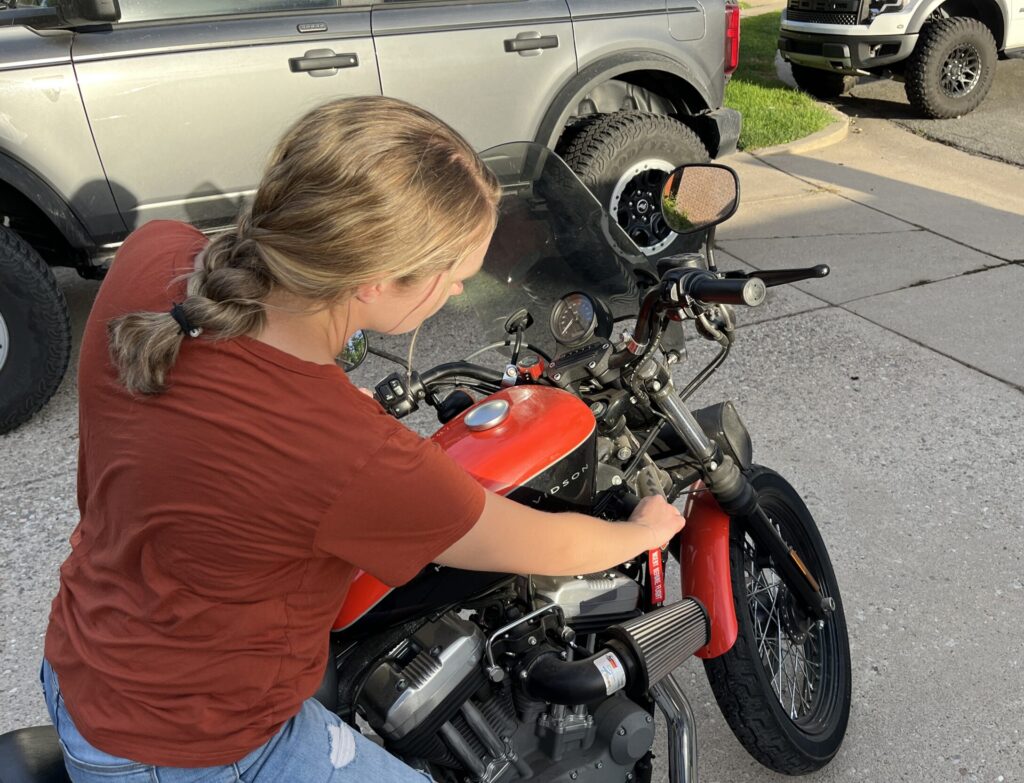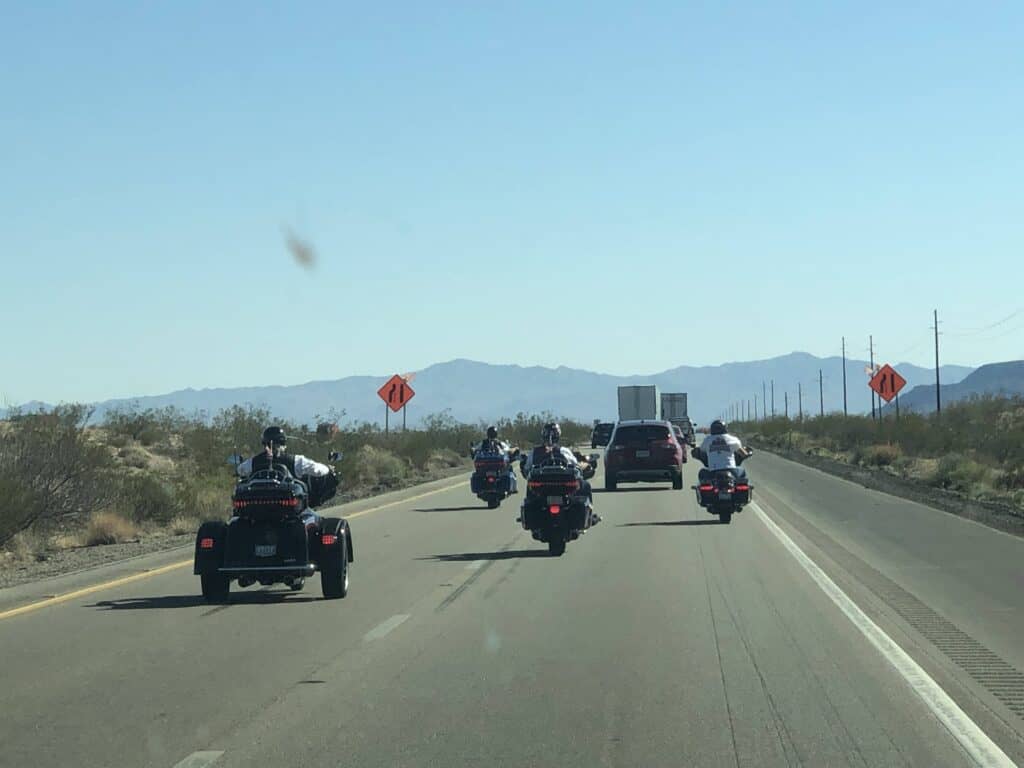
There are a million reasons why people idle their motorcycles. Sometimes people intentionally idle their motorcycles to warm them up while other times people leave them running while they run an errand or go inside a building.
Idling is something that will happen for a variety reasons, but is it bad to let a motorcycle idle? Letting a motorcycle idle is not bad provided that it is not done excessively. Liquid cooled motorcycles can tolerate idling better compared to air cooled motorcycles. Outside temperature should be considered when it comes to letting an air cooled engine idle.
Let’s discuss further about whether or not idling is good for your motorcycle, idling an air-cooled motorcycle vs. a water cooled one, how to handle idling in traffic, and symptoms that you’ve let your motorcycle idle too long.
Idling: Good Or Bad?
There is not a very straightforward answer to this question. The truth is it depends. Idling is necessary at times. You may want to warm your motorcycle up before performing some routine maintenance, before going on a ride, or you may be stuck in traffic.
Doing these things in themselves is not necessarily bad but consistently letting your bike idle for too long will lead to problems. The main concern here is that when you are idling, your motorcycle is not running at the ideal temperature. The air and fuel entering the engine are not burning as desired and as such, there is an excess that is not being combusted. This excess then goes on to settle onto engine and exhaust components.
This can build up on valves, cylinder walls, and all the way through the exhaust. These contaminants will continually build up and can eventually restrict air flows. If buildups ever break off, they can then damage components internally.
Although most modern motor oils contain additives to help remove these buildups, they are meant to handle buildups from everyday use. Excessive idling will result in excessive buildup and your oil is not meant to tackle this on its own. As such, you should always avoid idling for long periods of time when possible.
There are also other lesser reasons for which you will want to avoid long periods of idling. One such reason is gas consumption; Ultimately, idling is wasting gas. When your motorcycle is not moving, you are burning gas without getting anywhere. There is also the environmental outlook on idling since your motorcycle is outputting emissions.
A good general rule would be that if you are ever going to leave your bike for a minute or longer, it’s probably best to turn it off. Anything longer than a minute warrants turning the motorcycle off and then back on when you return. This will help improve the life and performance of your engine as well as help you save money down the road.
Idling An Air-Cooled Motorcycle Vs. A Water Cooled Motorcycle
Air-cooled motorcycles were the norm for a very long time. These bikes use the outside air and the wind as you ride to cool your motorcycles engine. This is much easier to do in motorcycles than it is in cars as the engine itself is much more exposed. Most of my motorcycles have been air cooled.
In a car, the engine would be underneath a hood and behind a bumper allowing only minimal amounts of air to pass through the grill. That is why cars have not utilized a liquid engine cooling system that incorporates a cooling fluid and a radiator.
As motorcycles have been improved over time, more and more liquid cooled bikes are appearing. These operate much more like cars in that they use a cooling liquid to remove heat from the engine which is then cooled in a heat exchanger. There are pros and cons to both air-cooled and liquid-cooled motorcycles.
One major con to air-cooled motorcycles surfaces when idling your bike. An air-cooled motorcycle relies heavily on the air blowing against your bike as you drive down the road. When your bike is idling, heat is only transferred to the nearby stagnant air. This results in significantly less heat being pulled from the engine. This could pose a problem if the engine were to get too hot.
Although this will not cause your engine to overheat in every situation, there are some in which it will. For example, if you are in Phoenix over the summer and leave your bike idling in 115-degree weather, the chances that your bike overheats are much greater than normal.
In a liquid cooled motorcycle, you will still have heat transfer occurring with the cooling liquid passing through the engine. Liquid cooling operates better when driving down the road and still maintain your bike’s engine temperature while idling. Depending on the type of motorcycle you have, you may want to consider the temperature that day if you are planning on idling for a long period of time or if you will be in stop and go traffic.
How To Handle Idling In Traffic

After reading the above paragraph, you might be concerned about your motorcycle overheating while waiting in traffic. What is the best way to let your bike idle when you find yourself in this situation?
If your motorcycle is liquid-cooled it will be able to idle in traffic all day long without overheating, assuming it’s all functioning properly. If your bike is air-cooled this may be a bit more of a concern. Should you turn your bike off and restart it again when traffic starts moving? The simple answer is no. The only time that you should be turning your motorcycle off is if it has actually overheated. (Click here to learn some tips on how to prevent your motorcycle from overheating)
Even if the temperature is slightly higher than normal, it is best to avoid shutting it off. An already hot engine usually has a much harder time starting again than normal. Turning off your motorcycle on the road also puts you as the rider in danger. In traffic jams, drivers frequently get frustrated, angry, and aggressive. These drivers will be looking around for the absolute quickest route through the traffic.
Unfortunately, motorcycles are very easy to miss when looking around. If an aggressive driver does not see you and tries to pull across where you are, you may be in danger. If your bike is turned off, you will not be able to react quickly enough with the bike.
This will keep you safe and prevent you from being unable to restart your bike on the side of the road. If you get concerned about your engine temp, look for a place where you can pull off and drive freely at about 35 MPH. This will quickly cool the engine back down to the normal temperature. Having lived in Moab, Utah and southern Mississippi, I’ve seen some pretty brutal heat while idling in traffic on my motorcycle. I’ve found these tips to work best.
Signs You’ve Let Your Motorcycle Idle Too Long
If you frequently let your motorcycle idle for very long periods of time, there may start to be signs indicating that you have excessive carbon buildup in the engine. These signs may not be super apparent at first, but in time will continue to get worse and worse as the buildup gets worse.
The first major sign is a loss of power. If you open up the throttle and notice that your motorcycle feels much more sluggish than normal, one possible cause would be carbon buildup in the engine.
Another slightly more concerning sign is that your bike is not running as smoothly. You may notice odd shakes, vibrations, or jerks. These are especially prevalent at idle. If your engine is running rough in any way, one possible culprit is engine build up. You may also notice a decrease in fuel economy over time.
If any of these signs are surfacing, you should consider cleaning out the engine; auto part stores sell bottles of solutions that you can use to clean out those deposits. Some oils are also better than others at removing them, so make sure to never purchase the cheapest oil during oil changes.
As a last resort, you can take the engine apart and either have components cleaned or replaced, preferably from a professional if you’ve never done anything like that yourself before. All of this work can be avoided for the most part by making sure that your bike is never idling for an excessive period of time.
Conclusion
The debate over whether it’s bad to let a motorcycle idle depends on various factors such as engine design, maintenance practices, and ambient temperatures. While idling can serve practical purposes such as warming up the engine or maintaining operational readiness, prolonged idling can lead to fuel wastage, increased emissions, and potential wear on engine components.
As a rule of thumb, if you think your motorcycle will be idling for longer than a minute or two, it’s best to turn it off then start it back up again when you can actually start going. Our hope is that after reading this article, you’re more confident in your riding skills and can keep your motorcycle going for years to come!
